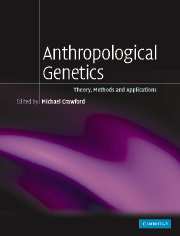Book contents
- Frontmatter
- Contents
- List of Contributors
- Preface
- Chapter 1 Foundations of Anthropological Genetics
- Part 1 Theory
- Part 2 Methods
- Part 3 General Applications
- Part 4 Part IV The Human Diaspora
- Chapter 12 Human Origins Within and Out of Africa
- Chapter 13 The Peopling of Europe
- Chapter 14 The Peopling of Oceania
- Chapter 15 The Prehistoric Colonization of the Americas
- Chapter 16 Anthropological Genetics: Present and Future
- Index
- References
Chapter 16 - Anthropological Genetics: Present and Future
Published online by Cambridge University Press: 05 June 2012
- Frontmatter
- Contents
- List of Contributors
- Preface
- Chapter 1 Foundations of Anthropological Genetics
- Part 1 Theory
- Part 2 Methods
- Part 3 General Applications
- Part 4 Part IV The Human Diaspora
- Chapter 12 Human Origins Within and Out of Africa
- Chapter 13 The Peopling of Europe
- Chapter 14 The Peopling of Oceania
- Chapter 15 The Prehistoric Colonization of the Americas
- Chapter 16 Anthropological Genetics: Present and Future
- Index
- References
Summary
Introduction
When Michael Crawford asked me to write a final chapter for this volume he suggested that I write some ‘science fiction’ and that I should ‘let myself go’. I will take him at his word in what follows, assessing several areas of anthropological genetics in terms of their likely short-term directions and consequences. I discuss anthropological genetics specifically rather than any of the rest of human genetics since there is no shortage of science fiction available about the latter.
If there is a coherent theme in my story it is that some areas of our discipline will soon find themselves at the centre of public debates about important political, social justice and educational issues. This will be caused by market forces in some cases and by new data about human genetic diversity that will force a drastic reassessment of our views about the possibility of group equalities in contemporary industrial societies. As a discipline there is a sense in which we have had our heads hidden in the sand, earnestly teaching our students about lactase and HbS and about G6PD while maintaining the fiction, or failing to deny the fiction, that humans don't really differ at all in traits that have large visible social consequences. Other areas of our discipline will in the near future enjoy less visibility than they do now, for example the effort to read global human history from patterns in the neutral genome.
- Type
- Chapter
- Information
- Anthropological GeneticsTheory, Methods and Applications, pp. 456 - 466Publisher: Cambridge University PressPrint publication year: 2006



